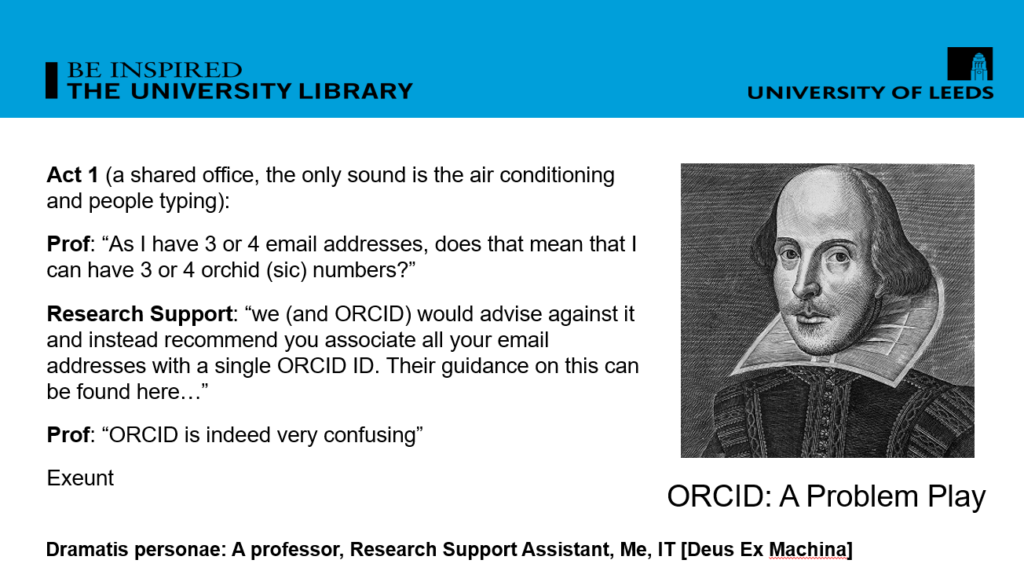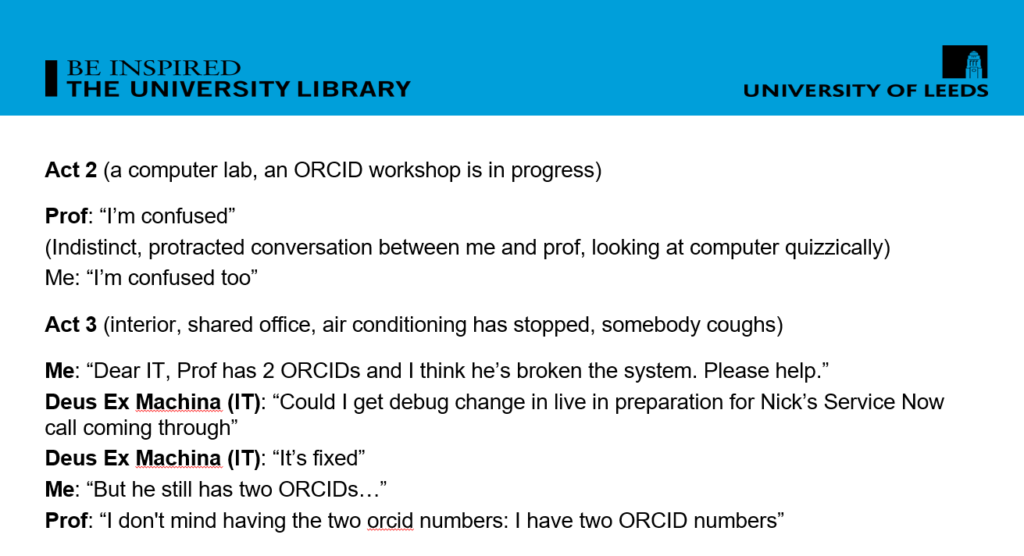ORCIDs in the Wild: A Field Guide to the Popular Persistent Identifier
The Open Researcher and Contributor IDentifier (ORCID) launched as the persistent identifier for active people within scholarship 6 October 2012, has grown in use and popularity. The ORCID iD and the underlying ORCID record in the global registry, accessed via a RESTful API, can confidently be said to be the default way to identify real people in a meaningful and persistent way internationally.
The Standard
A perfect example of the standard ORCID iD and associated record is a cherished and well-maintained narrative of the owner. Linked where possible via an ever-growing infrastructure of integrated systems, the record can auto update from a wide variety of resources, as well as inform scholarly architecture, saving the owner, and wider communities, time and knowledge capital. Concerned not only with STEM textual outputs, an ORCID record can give information on funding, conferences, contributions to work, reviews, use of research resources and so much more. Over the years ORCID has developed and been used in so many countries, systems and infrastructures across the scholarly space.
However, as with any system in place and used over a long time, some unforeseen usage has crept in…
Clumping
One example of surprising ORCID usage is the clumping of the identifier around a particular person, so that it is not uniquely identifying, i.e. one person registers more than one identifier. This can result from a researcher not quite understanding that they need only one ORCID iD, or accidentally, as when a researcher forgets they’ve already created a record for themselves so they create a duplicate one. But this often happens when, instead of treating the record as a treasured and important part of an online identity, it is simply considered as a thing useful temporarily as part of a workflow – the “number that I need to submit a grant or paper as P.I.” thing (it’s not always a number).
Examples from the University of Leeds include an enquiry to the Research Support team from a Professor who wanted to know if he can have “3 or 4 orchid (sic) numbers” for each of his different email addresses. On another occasion, in an ORCID workshop we ran into difficulty when a researcher with 2 ORCID IDs had connected the “wrong” one to the university HR system which we weren’t able to amend without the help of IT support.
Nick Sheppard, University of Leeds
An anecdotal report even has one individual with 11 ORCID iDs! It’s important to ensure our advocacy and communication around ORCID records highlights that it is intended to work as a single unique identifier, carried around like a passport with stamps in it from all the places visited. At the same time it’s important that we remove barriers to using the iD in systems and make it as easy as possible to have that identifier incorporated without additional steps and cognitive / process effort. This can be achieved by reusing the identifier through system-system interactions.
Grafted
Sometimes, instead of clumping, an ORCID record can find itself in the shade of a group, as a solitary record, with many individuals clustered around it.
At Northampton, we had a small group of Chinese PGR students who had one person signed up on behalf of them – and then they used that ORCID iD for all of their joint and separate publications… And we had a married couple who decided like everything else they do (facebook, banking) to have a joint orcid (despite their research being in different fields!).
Dawn Hibbert, University of Northampton
Here we see that the idea of having each individual being recognised is not being valued. So, we need to ensure that the concept of the personal persistent identifier is in place at the forefront of the user of an ORCID iD as they obtain one.
Neglected
Unfortunately, there are also the neglected ORCID records, possibly once well looked after (but sometimes just empty and obtained, as described above, to serve an immediate purpose, e.g. just to submit a paper), but now left to slowly moulder. These aging records are the hollow molehills of the scholarly landscape, there to trip the unwary with out-of-date information and incomplete narratives. Part of the advocacy message around ORCID should include reminders to set up auto update and link ORCID records to other sources of personal and scholarly information (alongside institutional logins) as a part of the ownership and culture of the community.
Horticultural Best Practice
As always, proper maintenance and respect for the ORCID iD, as with anything that benefits from regular upkeep, leads to the best, most useful record – to the researcher and the wider scholarly research fabric.
ORCID have information on how to manage duplicate ORCID iDs and a feature to merge duplicated iDs . Their support team can always help users with this and other issues: https://support.orcid.org/hc/en-us/requests/new . Paula Demain, Head of Product at ORCID, reports that
“Improvements are also being worked on in the user journey for creating an ORCID to try and reduce the possibility of creating additional iDs for the same individual.”
Summary
The ORCID iD personal persistent identifier is the de facto way to identify a person in the scholarly community. In general it is a robust and well implemented way to collect the narrative of participants in the research landscape, despite some atypical use when an individual registers more than one ID simply for convenience, or one ORCID ID is shared by several. Recently ORCID published a blog post to introduce the concept of “trust markers” in an ORCID record. In it they outlined how users of ORCID data can determine for themselves which kinds of data in an ORCID record they consider to be trust markers for their specific use case.
A version of this document is available in the UK ORCID Consortium Teams site so that members can contribute their own experience
Excerpt from Presentation (University of Leeds)
Used with Permission (Nick Sheppard)


